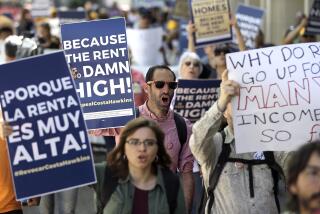County to Study Ban on Housing Density Increases in N. County
- Share via
Hoping to curb runaway growth in North County but uncertain over how best to accomplish that goal, the county Board of Supervisors on Wednesday directed the county staff to develop plans for a one-year ban on increases in housing density.
The one-year ban would prohibit General Plan amendments and zoning reclassifications that increase “density or intensity” in the unincorporated areas of the county, unless the proposals have the support of a local planning group or offer what the supervisors see as substantial public benefits. The proposal, made last month by Supervisors John MacDonald and George Bailey, would allow developments that comply with current zoning to proceed as usual.
However, Wednesday’s lengthy debate at the County Administration Center illustrated the difficulty of executing even a seemingly simple concept in a policy area as knotty and complex as growth management. In the end, the supervisors, admitting that they needed more time to sort out myriad questions raised at the meeting, voted unanimously to ask the county staff to return on April 22 with various methods of enacting the proposed one-year ban.
Wednesday’s hearing began with questions over semantics that wound their way through the entire meeting. MacDonald repeatedly insisted that the proposal should not be termed a “moratorium” or “freeze,” even though the plan essentially would function as such.
“It’s a holding pattern, basically,” MacDonald explained. “This is not a moratorium in the strictest sense.”
But lawyer Lou Wolfsheimer, former chairman of the San Diego Planning Commission, responded: “I don’t care what you call it, if it has a tusk and a trunk, it’s probably an elephant.” Wolfsheimer is now a land-use attorney.
There were questions over definitions that could dramatically affect the proposed one-year ban’s application. Land-use lawyers, construction industry representatives and others questioned, for example, precisely what increasing the “intensity” of land-use meant.
“We’re still working on that definition,” MacDonald answered.
Similarly, because projects “in the pipeline” would be exempt from the ban, numerous speakers wondered whether the “pipeline” began at the moment a development plan was filed with the county or further along in the approval process. The former definition could precipitate a deluge of proposals before the proposed ban takes effect, while the latter could unfairly penalize developers who already have spent considerable time and money on projects still in the early stages of review by county planners.
There also were questions over whether it was wise--or legal--to entrust community planning groups with more authority to recommend or block development proposals. Such groups usually are composed, lawyer J. Michael McDade told the supervisors, of people with “good intentions but no expertise in planning (who) lack the regional perspective that you were elected to give us.”
In addition, county lawyers and private attorneys cautioned the supervisors that there might be legal problems if community groups were given any decision-making responsibilities, rather than simply serving as advisory bodies, as they do now.
Currently, a developer can appeal to the supervisors if a local planning group rejects his proposal. However, the proposed ordinance, as originally put forth by MacDonald and Bailey, would eliminate that option and preclude developers from taking their case to the supervisors.
Finally, there were questions over whether the proposed housing density ban is necessary or would give the supervisors any authority beyond that which they already possess. Supervisor Susan Golding pointed out that a majority of the supervisors can block any proposal to increase housing density simply by voting against it. The proposed one-year ban, therefore, would “not do anything . . . we can’t already do,” Golding noted.
The primary value of the proposal, she added, may be that it “buys time” while a county task force completes its study of the impacts of growth and development. The ban also would help, she said, to “get the word out that this is happening” so that developers “don’t waste time and money coming before” the supervisors.
Wolfsheimer, however, described that message as unnecessary.
“Land developers understand what’s happening--you don’t have to hit them over the head with a 2-by-4,” Wolfsheimer said. “They understand it’s going to be difficult . . . to get some crazy (development proposal) through the county.”
MacDonald, though, argued that the proposed ban is needed because community planning leaders feel that their advice is too often ignored or circumvented via developers’ appeals to the Board of Supervisors. That attitude, the supervisor added, was a major motivating force behind the incorporations of Solana Beach and Encinitas last year.
“And I can guarantee you that, if we don’t do something in this direction . . . we’re going to have at least two more incorporations within the year,” MacDonald said, referring to Rancho Santa Fe and Fallbrook--two areas where incorporation as cities is being considered.
More to Read
Sign up for Essential California
The most important California stories and recommendations in your inbox every morning.
You may occasionally receive promotional content from the Los Angeles Times.













